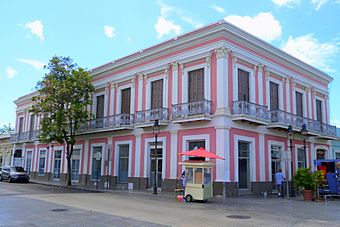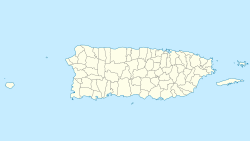Casa Vives facts for kids
Quick facts for kids |
|
|
Casa Vives
|
|

Casa Vives in 2017
|
|
| Location | 88 Paseo Atocha at Calle Castillo Ponce, Puerto Rico |
|---|---|
| Area | 1,174 square meters (12,640 sq ft) |
| Built | 1860 |
| Architect | Juan Bertoly Carderoni |
| Architectural style | Neoclassical |
| NRHP reference No. | 13000013 |
| Added to NRHP | 13 February 2013 |
Casa Vives, also known as Vives House, is a really old and important building in Ponce, Puerto Rico. It's right across from the old market, the Plaza de Mercado de Ponce. A famous architect named Juan Bertoli Calderoni designed it for Carlos Vives, who was a rich merchant and owned a big farm called Hacienda Buena Vista.
The house was built in 1860. It was one of the first homes in Ponce made with brick and mortar. Its style is called Neoclassical, which means it looks like ancient Greek and Roman buildings. Because of its history and design, Casa Vives was added to the U.S. National Register of Historic Places on February 13, 2013.
Contents
Discovering Casa Vives
Casa Vives is a large, two-story building shaped like an "L". You can find it at 88 Paseo Atocha, on the corner of Castillo Street. This area is part of the old city center of Ponce. The house has a flat roof with a low wall around it, called a parapet.
Experts believe Juan Bertoli Calderoni designed this beautiful house. It was built by Carlos Milan. Casa Vives is one of the best-preserved 19th-century houses in all of Puerto Rico. Its fancy details and strong materials show how important it was. It represents the grand homes of rich families in the 1800s.
Why Was Casa Vives Built This Way?
Casa Vives stands on a very important corner. Its main entrance faces Atocha Street, which was a busy shopping street. The long side of the building faces Castillo Street, another important road. It's directly across from the old market building, the Plaza del Mercado de Ponce.
In the 1800s, wealthy people in Ponce wanted to show off their success. They used their homes to express their social status. This led to a unique building style in Ponce, different from other cities like Old San Juan. In Ponce, each family tried to make their house special. This created a diverse and interesting city look. Casa Vives is a great example of this idea.
What Does Casa Vives Look Like?
Casa Vives was built for two purposes: shops on the first floor and a home upstairs. Because of this, the outside of the building looks different on each level.
The first floor, where the shops were, has a simpler design. It has doors and windows framed by simple moldings and flat columns called pilasters. These pilasters look like Tuscan columns. A flat band, called an architrave, runs above them, clearly separating the shops from the home above.
The second floor, where the family lived, looks much fancier. It has many openings, with 13 sets of wooden double doors. Nine face Castillo Street, and four face Paseo Atocha. Each doorway has balconies, plaster moldings, and triangular decorations called pediments. These are all framed by fancy Corinthian pilasters. The balconies still have their original wrought iron railings from the 1800s. A strong, decorative band, called an entablature, crowns the top of the building.
Shops on the First Floor
The ground floor of Casa Vives was always used for businesses. Since it's on a corner, it has three different shop areas. The floors in these areas were changed in the early 1900s to native tiles.
One section has a 12-foot high ceiling covered with decorative pressed tin panels. This was a popular fancy touch in the 1920s. The other two shop areas have even higher ceilings, about 17 feet. Here, you can still see the original exposed ausubo wood beams. These beams support the upper floor.
The inside walls of the first floor show the original bricks. Each shop area has its own small service room. The shops facing Castillo Street have four large glass windows and four glass doors. The side facing Paseo Atocha has one glass door and two large windows.
All three shop spaces have access to a narrow backyard. A seven-foot brick wall separates this area from a large, open garden-like patio. This patio was only for the family living upstairs. On the Castillo Street side, there's an arched wooden gate. This gate led to the cochera, which was like a garage. In the 1860s, it held the family's horse stagecoach. Later, in the early 1900s, it housed early cars like the Ford Model T.
Family Home on the Second Floor
You enter the family's home on the second floor through an original double-door wooden gate on Paseo Atocha. Inside, there's an impressive zaguan (a long hallway) with a 17-foot high ceiling. The walls are decorated with painted patterns.
Halfway down the zaguan, a Roman arch painted to look like marble leads to a beautiful marble staircase. This staircase has eight steps and bronze handrails. At the stair's landing, there are two fancy iron gates. One leads to the second floor, and the other to the patio. On the gate facing the zaguan, you can see the letters "CV" for Carlos Vives, the original owner. Another marble staircase then takes you up to the second floor.
The second floor has 15 rooms. These include bedrooms, a living room, a family room, a dining room, a kitchen (with an original 19th-century stove), a bathroom, and a studio or library. The rooms are arranged in an L-shape. Three large rooms with 15-foot high ceilings face Paseo Atocha. The bedrooms, kitchen, bathroom, and dining room line up along Castillo Street. This part of the house was more private.
Each room facing the patio has a special double-door system. First, there's a wooden double door with adjustable louvers and a frosted glass panel above it. Then, there's another solid mahogany double door that covers the whole opening.
A long, 48-foot gallery connects the rooms. This gallery has wooden railings and movable wooden shutters. These shutters provided shade and allowed air to flow through, which was important in Ponce's hot weather.
The house has high ceilings (14 to 15 feet) to let hot air rise. There are also decorative ventilation holes in the corners of each room's ceiling. These let hot air escape through the roof. Fresh air comes in through special brick structures on the roof, which face the usual wind direction. Every room connects to the next with double wooden doors, helping air move around. Many inside doors also have open panels above them, called transoms, for air circulation even when the doors are closed.
Most walls in the house are decorated with hand-painted patterns. These include geometric shapes, garlands, pilasters, and columns. The floors are made of wooden planks from a local tree called tabloncillo. However, the gallery floor has hydraulic cement tiles, added in the early 1900s. The ceilings are also wooden planks, often decorated with painted designs.
The Backyard Patio
The L-shape of the house, along with other buildings and a brick fence, hides a green inner patio. You can reach this patio from the zaguan, the carport, or directly from the second floor using a brick staircase.
In 2013, the house was empty, and the patio looked a bit neglected. But it still has interesting features. There's a marble staircase, just like the one in the zaguan, and an iron gate that matches it. Old family photos show the Vives family often used this staircase and patio for pictures. A water fountain sits in the middle of the patio, another popular spot for photos.
There are also two old brick buildings in the patio. In the 1800s, these were homes for the house staff.
Roof and Outside Details
You can get to the roof using an inside wooden stair. The roof is made of three layers of thin bricks, as was common in the 1860s. A three-foot high parapet surrounds it. The roof has the special ventilation structures mentioned earlier.
The way the roof drains water is very clever. It slopes slightly to one side, guiding rainwater. The edge of the roof is also shaped to direct water into drainage holes. Historical records say that the rainwater collected on the roof went into a well in the patio.
Why Casa Vives is Important
Casa Vives is important because it shows us how people built things in the 1800s. It's a great example of the skills and building methods of that time. It also shows how cities like Ponce grew and developed.
The house also tells us about the social dreams of rich families in the 19th century. They used grand architecture to show their wealth and status. Casa Vives was a way for the Vives family to show their importance to the city. It was also seen as a "gift" to the people of Ponce, making the city more beautiful.
Ponce's Growth and Trade
Casa Vives is connected to Ponce's growth in the 1800s. At the end of the 1700s, Ponce was a small town. But by 1878, it had become a busy city with many streets and homes. This growth was thanks to farming and trade.
In the early 1800s, Puerto Rico's farms became very important. Cities with good ports, like Ponce, grew quickly. Ponce's port, opened in 1804, helped it become a major center for trade. It exported goods from its own farms and from nearby towns. By 1890, Ponce handled 33.2% of all exports from the island.
Ponce's strong economy also attracted many influential immigrants. Events like the Haitian Revolution and new Spanish government policies encouraged wealthy foreigners to move there. They started large farms, especially for sugarcane, and built homes in Ponce. Don Salvador de Vives, who started the Vives family in Puerto Rico, arrived in Ponce in 1821. His son, Carlos Vives, later owned Casa Vives.
Ponce's economy relied on two main crops: sugar and coffee. The sugar industry also led to the use of slavery. In Ponce, slavery was very common. By 1845, slaves made up 23% of Ponce's population. For example, slaves were the main workers at the Vives family's Hacienda Buena Vista.
The trade of sugar, coffee, and other crops made a strong business class in Ponce. These rich families, along with the landowners, shaped the city. They built new buildings, installed lights, paved streets, and built theaters. This created a lively city life. Many skilled workers like carpenters, artisans, and architects came to Ponce, helping the city grow even more.
Because of its strong farming and trade, Ponce became the richest city in Puerto Rico. By 1890, it paid the most taxes to the government.
Damage from the 2020 Earthquake
In January 2020, the 2020 Puerto Rico earthquake caused a lot of damage to Casa Vives.


